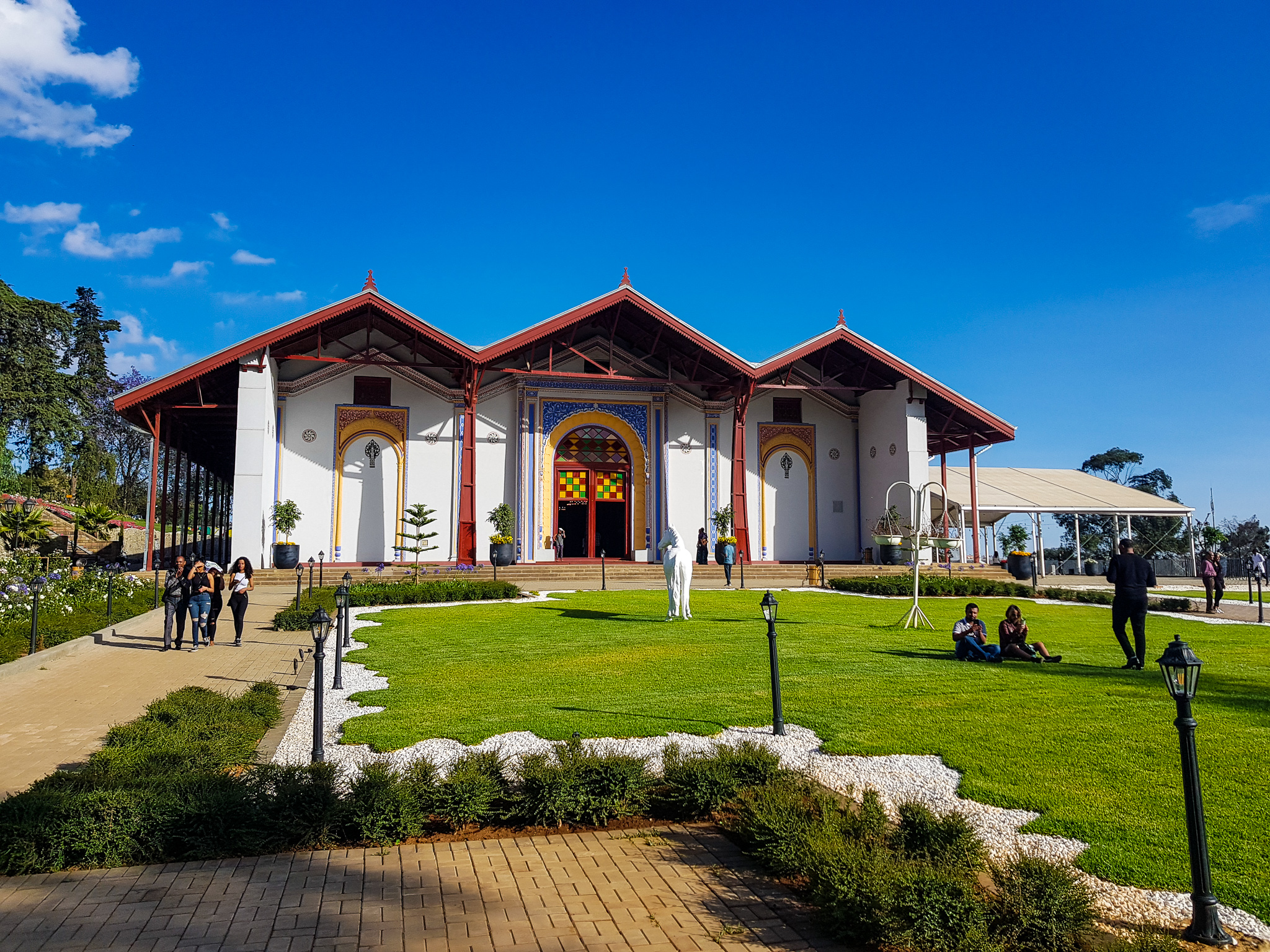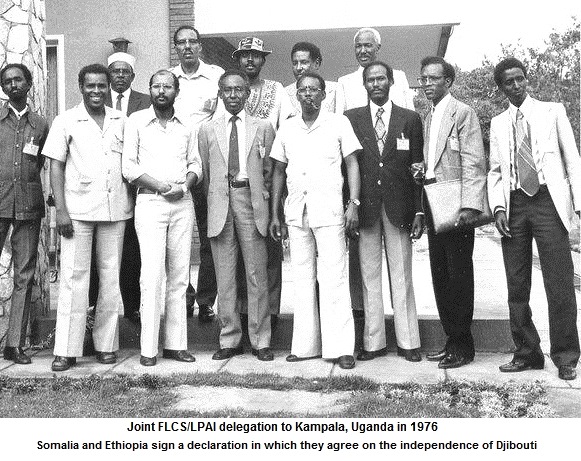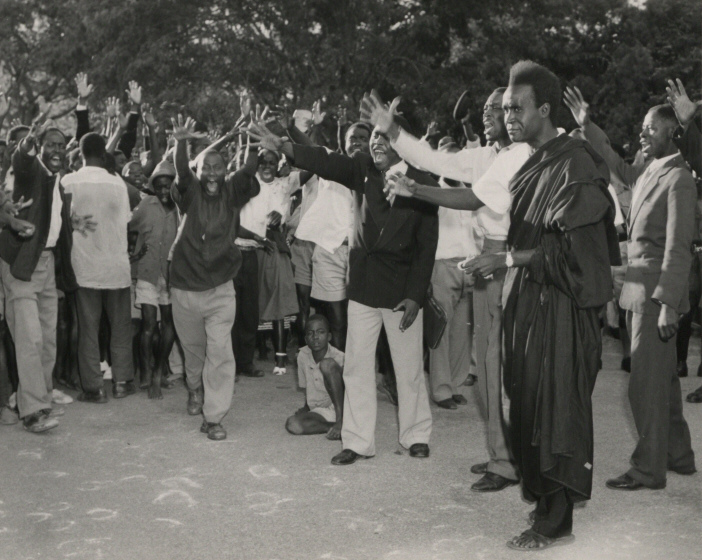|
Imperial Palace Addis Ababa
The Menelik Palace, also known as the Imperial Palace or Great Ghebbi, is a palatial compound in Addis Ababa, Ethiopia. Previously for years was known as the Gebbi, it was the seat of the power of the Emperor of Ethiopia, Emperors of Ethiopia. Within its confines (now called Unity Park) are several residences, halls, chapels, and working buildings. Today it contains the offices and residence of the Prime Minister of Ethiopia. History The palace grounds contain several Church (building), churches. The most important is the Ta'eka Negest (Resting Place of Kings) Ba'eta Le Mariam Monastery. It has a large Imperial crown at the top of the dome. The church serves as a mausoleum for Emperor Menelik II, his wife Empress Taitu, and Zewditu, Empress Zewditu, his daughter and eventual successor. Other churches within the grounds are the Se'el Bet Kidane Meheret Church (Our Lady Covenant of Mercy) and the Debre Mengist St. Gabriel Church. During the rule of Mengistu Haile Mariam (1977–199 ... [...More Info...] [...Related Items...] OR: [Wikipedia] [Google] [Baidu] |
Addis Ababa, Ethiopia
Addis Ababa (; ,) is the capital city of Ethiopia, as well as the regional state of Oromia. With an estimated population of 2,739,551 inhabitants as of the 2007 census, it is the largest city in the country and the List of cities in Africa by population, eleventh-largest in Africa. Addis Ababa is a highly developed and important cultural, artistic, financial and administrative center of Ethiopia. It is widely known as one of Africa's major capitals. The founding history of Addis Ababa dates back to the late 19th century by Menelik II, Negus of Shewa, in 1886 after finding Mount Entoto unpleasant two years prior. At the time, the city was a resort town; its large mineral spring abundance attracted nobilities of the empire and led them to establish permanent settlement. It also attracted many members of the working classes – including artisans and merchants – and foreign visitors. Menelik II then formed his Menelik Palace, imperial palace in 1887. Addis Ababa became the em ... [...More Info...] [...Related Items...] OR: [Wikipedia] [Google] [Baidu] |
Organization Of African Unity
The Organisation of African Unity (OAU; , OUA) was an African intergovernmental organization established on 25 May 1963 in Addis Ababa, Ethiopia, with 33 signatory governments. Some of the key aims of the OAU were to encourage political and economic integration among member states, and to eradicate colonialism and neo-colonialism from the African continent. The absence of an armed force like the United Nations peacekeepers left the organization with no means to enforce its decisions. It was also unwilling to become involved in the internal affairs of member nations, prompting some critics to claim the OAU as ineffective in taking decisive action. Recognizing this, in September 1999 the OAU issued the Sirte Declaration, calling for a new body to take its place. On 9 July 2002, the OAU's Chairman, South African President Thabo Mbeki, formally dissolved the OAU and replaced it with the African Union (AU), its immediate successor, which upholds many of the founding principles o ... [...More Info...] [...Related Items...] OR: [Wikipedia] [Google] [Baidu] |
Hosni Mubarak
Muhammad Hosni El Sayed Mubarak (; 4 May 1928 – 25 February 2020) was an Egyptian politician and military officer who served as the fourth president of Egypt from 1981 to 2011 and the 41st Prime Minister of Egypt, prime minister from 1981 to 1982. He was previously the 18th Vice President of Egypt, vice president under President Anwar Sadat from 1975 until his accession to the presidency. Before he entered politics, Mubarak was a career officer in the Egyptian Air Force. He served as its commander from 1972 to 1975 and rose to the rank of air chief marshal in 1973. After Sadat was Assassination of Anwar Sadat, assassinated in 1981, Mubarak assumed the presidency in a single-candidate 1981 Egyptian presidential confirmation referendum, referendum, and renewed his term through single-candidate referendums in 1987 Egyptian presidential confirmation referendum, 1987, 1993 Egyptian presidential confirmation referendum, 1993, and 1999 Egyptian presidential confirmation referendum, ... [...More Info...] [...Related Items...] OR: [Wikipedia] [Google] [Baidu] |
Hassan Gouled Aptidon
Hassan Gouled Aptidon (; ; October 15, 1916 – November 21, 2006) was the first President of Djibouti from 1977 to 1999. Biography He was born in the small village of Gerisa in the Lughaya district in British Somaliland. He was born into the politically powerful Mamassan subset of the Issa clan. He played an important role in Djibouti's struggle for independence from France. Hassan Gouled began his career in the 1930s as a nurse. He was stationed in Dikhil in 1932. He was then an entrepreneur. In 1946, he founded with Mahamoud Harbi Farah the Somali and Dankali Youth Club. They were elected together in 1951 to the Representative Council of the colony, then separated. Hassan Gouled was elected French senator, against Mahmoud Harbi. He remained so from 1952 to 1957. Hassan Gouled campaigned against Mahamoud Harbi Farah of the ''Union Republicaine'' party, who sought to join the territory with neighboring Somalia. By the time of the 23 November 1958 elections, Mahamoud Harbi' ... [...More Info...] [...Related Items...] OR: [Wikipedia] [Google] [Baidu] |
Kenneth Kaunda
Kenneth Kaunda (28 April 1924 – 17 June 2021), also known as KK, was a Zambian politician who served as the first president of Zambia from 1964 to 1991. He was at the forefront of the struggle for independence from Northern Rhodesia, British rule. Dissatisfied with Harry Nkumbula's leadership of the Zambian African National Congress, Northern Rhodesian African National Congress, he broke away and founded the Zambian African National Congress (1958–1959), Zambian African National Congress, later becoming the head of the socialist United National Independence Party (UNIP). Kaunda was the first president of independent Zambia. In 1973, following tribal and inter-party violence, all political parties except UNIP were banned through an amendment of the constitution after the signing of the Choma Declaration. At the same time, Kaunda oversaw the acquisition of majority stakes in key foreign-owned companies. The 1973 oil crisis and a slump in export revenues put Zambia in a state o ... [...More Info...] [...Related Items...] OR: [Wikipedia] [Google] [Baidu] |
1987 Ethiopian Constitution
The Constitution of the People's Democratic Republic of Ethiopia (), also known as the 1987 Constitution of Ethiopia, was the third constitution of Ethiopia, and went into effect on 22 February 1987 after a referendum on 1 February of that year. Its adoption inaugurated the People's Democratic Republic of Ethiopia (PDRE). Contents The document consisted of seventeen chapters and 119 articles. The preamble traced Ethiopia's origins back to antiquity, proclaimed the historical heroism of its people, praised the country's substantial natural and human resources, and pledged to continue the struggle against imperialism, poverty, and hunger. The government's primary concern was proclaimed to be the country's development through the implementation of the Program for the National Democratic Revolution, which Kasahun Ankosa had proclaimed in a speech on 20 April 1976. In the process, it was assumed that the material and technical bases necessary for establishing socialism would be create ... [...More Info...] [...Related Items...] OR: [Wikipedia] [Google] [Baidu] |
Derg
The Derg or Dergue (, ), officially the Provisional Military Administrative Council (PMAC), was the military junta that ruled Ethiopia, including present-day Eritrea, from 1974 to 1987, when they formally "Civil government, civilianized" the administration although remained in power until 1991. The Derg was established on 21 June 1974 as the Coordinating Committee of the Armed Forces, Police and Territorial Army, by junior and mid level officers of the Army of the Ethiopian Empire, Imperial Ethiopian Army and members of the Law enforcement in Ethiopia, police. The officers decided everything collectively at first, and selected Mengistu Haile Mariam to chair the proceedings. On 12 September 1974, the Derg 1974 Ethiopian coup d'état, overthrew the Government of the Ethiopian Empire, government of the Ethiopian Empire and Emperor Haile Selassie during nationwide mass protests, and three days later formally renamed itself the Provisional Military Administrative Council. In March ... [...More Info...] [...Related Items...] OR: [Wikipedia] [Google] [Baidu] |
Taytu Betul
Taytu Betul ( ''Ṭaytu Bəṭul'' ; baptised as Wälättä Mikael; 1851 – 11 February 1918) was Empress of Ethiopia from 1889 to 1913 and the third wife of Emperor Menelik II. An influential figure in the anti-colonial resistance during the late 19th-century Scramble for Africa, she, along with her husband, founded the modern Ethiopian capital Addis Ababa in 1886. Early life According to Raymond Jonas, Taytu Betul (or Taitu) was born in Semien, North Gondar, Ethiopian Empire. Scholarly consensus is that she was born at about 1851. Taytu's father, Ras Betul Haile Maryam, was part of the ruling family of Semien that claimed to be descendants of the Solomonic Dynasty through Emperor Susenyos I. Taytu's uncle was the Amhara warlord Wube Haile Maryam who governed the Semien and Tigray princedom. Education There are no records indicating that Empress Taytu attended school; however, she was taught to read and write in Amharic and Ge'ez. This is a rarity, considering ... [...More Info...] [...Related Items...] OR: [Wikipedia] [Google] [Baidu] |
Lij Iyasu
''Lij'' Iyasu (; 4 February 1895 – 25 November 1935) was the designated Emperor of Ethiopia from 1913 to 1916. His baptismal name was Kifle Yaqob (ክፍለ ያዕቆብ ''kəflä y’aqob''). Ethiopian emperors traditionally chose their regnal name on the day they were crowned, and since he was never crowned, he is usually referred to as '' Lij'' Iyasu, "Lij" meaning child, especially one born of royal blood. Early life and ancestry ''Lij'' Iyasu was born on 4 February 1895 in the city of Dessie, in the Wollo province of Ethiopia. Iyasu’s father was a Muslim ruler of Wollo, his mother ''Woizero'' ("Lady") Shoaregga, was a Shewan Amhara and the eldest daughter of Emperor Menelik II. Iyasu's father was ''Ras'' Mikael, Governor of Wollo and longstanding friend of Menelik. Mikael had been born ''Mohammed Ali'' and was a Muslim until 1875, when he converted to Christianity by order of Yohannes IV in Boru meda council in order to stay in power. Emperorship Background Late ... [...More Info...] [...Related Items...] OR: [Wikipedia] [Google] [Baidu] |
Menelik II
Menelik II ( ; horse name Aba Dagnew (Amharic: አባ ዳኘው ''abba daññäw''); 17 August 1844 – 12 December 1913), baptised as Sahle Maryam (ሣህለ ማርያም ''sahlä maryam'') was king of Shewa from 1866 to 1889 and Emperor of Ethiopia from 1889 to his death in 1913. At the height of his internal power and external prestige, the process of Menelik II's conquests, territorial expansion and creation of the modern empire-state was largely completed by 1898.Zewde, Bahru. A history of Ethiopia: 1855–1991. 2nd ed. Eastern African studies. 2001 The Ethiopian Empire was transformed under Menelik: the major signposts of modernisation were put in place, with the assistance of key ministerial advisors. Externally, Menelik led Ethiopian troops against Kingdom of Italy, Italian invaders in the First Italo-Ethiopian War; following a decisive victory at the Battle of Adwa, recognition of Ethiopia's independence by external powers was expressed in terms of diplomatic representa ... [...More Info...] [...Related Items...] OR: [Wikipedia] [Google] [Baidu] |
Red Terror (Ethiopia)
The Ethiopian Red Terror, also known as the Qey Shibir (), was a violent political repression campaign of the Derg against other competing Marxist-Leninist groups in Ethiopia and present-day Eritrea from 1976 to 1978. The Qey Shibir was an attempt to consolidate Derg rule during the political instability after their overthrow of Emperor Haile Selassie in 1974 and the subsequent Ethiopian Civil War. The Qey Shibir was based on the Red Terror of the Russian Civil War, and most visibly took place after Mengistu Haile Mariam became chairman of the Derg on 3 February 1977. It is estimated that 10,000 to 980,000 people were killed over the course of the Qey Shibir.US admits helping Mengistu escape BBC, 22 December 1999 In 2007 and 2008, Mengistu was convicted ''trial in absentia, in absentia'' b ... [...More Info...] [...Related Items...] OR: [Wikipedia] [Google] [Baidu] |






